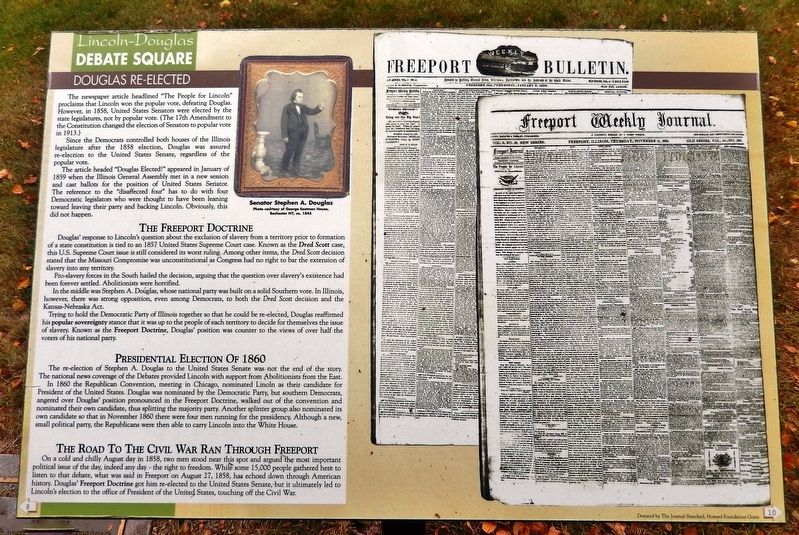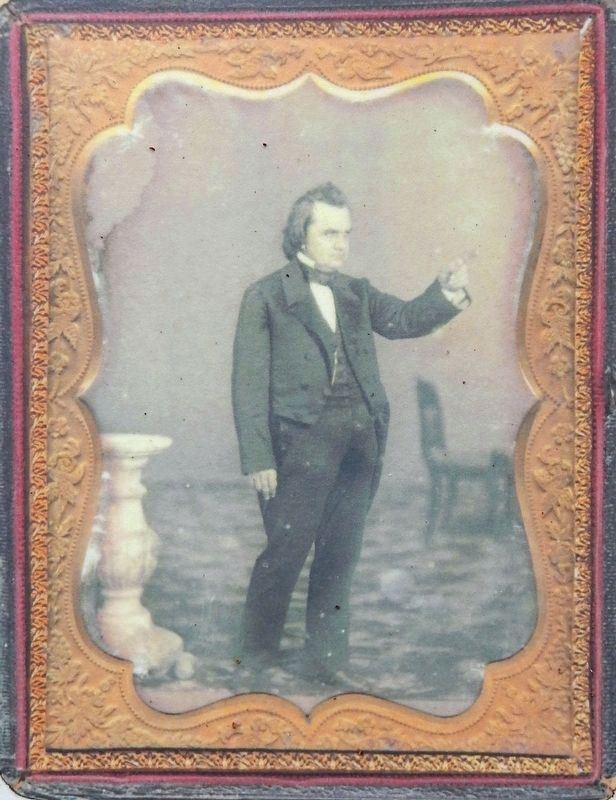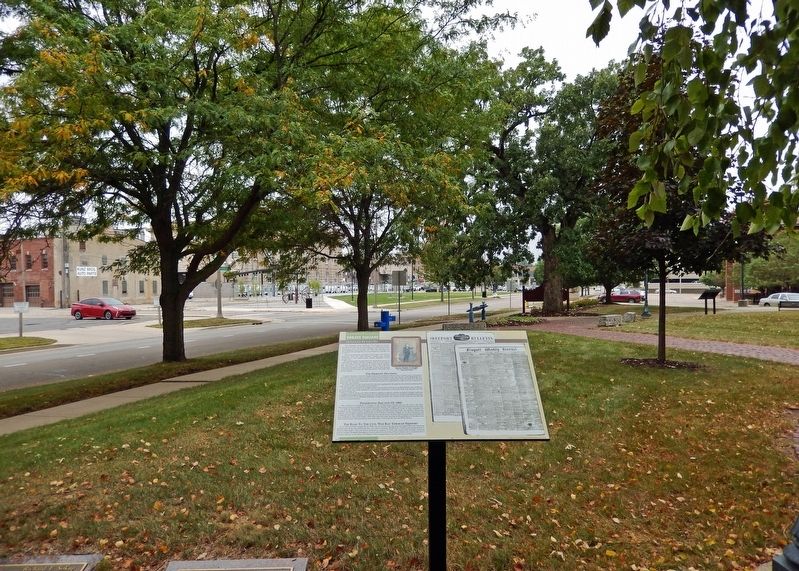Freeport Township in Stephenson County, Illinois — The American Midwest (Great Lakes)
Douglas Re-elected
Lincoln-Douglas Debate Square
The newspaper article headlined "The People for Lincoln" proclaims that Lincoln won the popular vote, defeating Douglas. However, in 1858, United States Senators were elected by the state legislatures, not by popular vote. (The 17th Amendment to the Constitution changed the election of Senators to popular vote in 1913.)
Since the Democrats controlled both houses of the Illinois legislature after the 1858 election, Douglas was assured re-election to the United States Senate, regardless of the popular vote.
The article headed "Douglas Elected!" appeared in January of 1859 when the Illinois General Assembly met in a new session and cast ballots for the position of United States Senator. The reference to the "disaffected four" has to do with four Democratic legislators who were thought to have been leaning toward leaving their party and backing Lincoln. Obviously, this did not happen.
Pro-slavery forces in the South hailed the decision, arguing that the question over slavery's existence had been forever settled. Abolitionists were horrified.
In the middle was Stephen A. Douglas, whose national party was built on a solid Southern vote. In Illinois, however, there was strong opposition, even among Democrats, to both the Dred Scott decision and the Kansas-Nebraska Act.
Trying to hold the Democratic Party of Illinois together so that he could be re-elected, Douglas reaffirmed his popular sovereignty stance that it was up to the people of each territory to decide for themselves the issue of slavery. Known as the Freeport Doctrine, Douglas' position was counter to the views of over half the voters of his national party.
In 1860 the Republican Convention, meeting in Chicago, nominated Lincoln as their candidate for President of the United States. Douglas was nominated by the Democratic Party, but southern Democrats, angered over Douglas' position pronounced
in the Freeport Doctrine, walked out of the convention and nominated their own candidate, thus splitting the majority party. Another splinter group also nominated its own candidate so that in November 1860 there were four men running for the presidency. Although a new, small political party, the Republicans were then able to carry Lincoln into the White House.
Erected by The Journal-Standard, Howard Education Grant.
Topics and series. This historical marker is listed in these topic lists: Abolition & Underground RR • African Americans • Government & Politics • War, US Civil. In addition, it is included in the Former U.S. Presidents: #16 Abraham Lincoln series list. A significant historical date for this entry is August 27, 1858.
Location.
42° 18.032′ N, 89° 37.169′ W. Marker is in Freeport, Illinois, in Stephenson County. It is in Freeport Township. Marker can be reached from the intersection of East Douglas Street (Illinois Route 75) and North State Avenue, on the left when traveling east. The marker is located along the walkway in Lincoln-Douglas Debate Square. Touch for map. Marker is at or near this postal address: 114 East Douglas Street, Freeport IL 61032, United States of America. Touch for directions.
Other nearby markers. At least 8 other markers are within walking distance of this marker. Robert J. Schmelzle (here, next to this marker); Richard F. Sokup (here, next to this marker); The Legacy Remains (here, next to this marker); Lincoln and Douglas in Debate 1858 (a few steps from this marker); Freeport Commemorates (a few steps from this marker); The Debates and the Media (within shouting distance of this marker); The Freeport Lincoln-Douglas Debate (within shouting distance of this marker); Debates' Structure (within shouting distance of this marker). Touch for a list and map of all markers in Freeport.
Related markers. Click here for a list of markers that are related to this marker. 2nd Lincoln-Douglas Debate • Freeport, Illinois
Also see . . .
1. 17th Amendment to the United States Constitution (Wikipedia). Excerpt:
The 17th Amendment to the United States Constitution established the direct election of United States senators in each state. The amendment supersedes Article I, Section 3, Clauses 1 and 2 of the Constitution, under which senators were elected by state legislatures. It also alters the procedure for filling vacancies in the Senate, allowing for state legislatures to permit their governors to make temporary appointments until a special election can be held.(Submitted on September 25, 2023, by Cosmos Mariner of Cape Canaveral, Florida.)
2. Dred Scott v. Sandford (Wikipedia). Excerpt:
The decision involved the case of Dred Scott, an enslaved black man whose owners had taken him from Missouri, a slave-holding state, into Illinois and the Wisconsin Territory, where slavery was illegal. When his owners later brought him back to Missouri, Scott sued for his freedom and claimed that because he had been taken into "free" U.S. territory, he had automatically been freed and was legally no longer a slave. In March 1857, the Supreme Court issued a 7–2 decision against Scott. The Court ruled that people of African descent "are not included, and were not intended to be included, under the word 'citizens' in the Constitution, and can therefore claim none of the rights and privileges which that instrument provides for and secures to citizens of the United States". The decision is widely considered the worst in the Supreme Court's history, being widely denounced for its overt racism, perceived judicial activism, poor legal reasoning, and crucial role in the start of the American Civil War four years later.(Submitted on September 25, 2023, by Cosmos Mariner of Cape Canaveral, Florida.)
Credits. This page was last revised on September 27, 2023. It was originally submitted on September 25, 2023, by Cosmos Mariner of Cape Canaveral, Florida. This page has been viewed 64 times since then and 13 times this year. Photos: 1, 2, 3. submitted on September 25, 2023, by Cosmos Mariner of Cape Canaveral, Florida.


